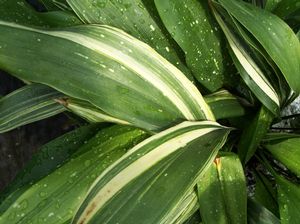View All Plants :: View All SHADE PERENNIALS
Aspidistra elatior 'Amanogawa'
Cast Iron Plant
Plant Type:
SHADE PERENNIALSAspidistra elatior ‘Amanogawa’ (ex: Jonathan Lehrer) – 'Amanogawa' is the Milky Way Galaxy Cast Iron Plant. (The actual translation for "amanogawa" from Japanese to English is "river of stars". Lovely, no? Thank you Meera!) Each leaf is loaded with spots and stripes of cream suggesting resemblance to a microcosmic rendition of the piece of the known universe to which we belong. It's a beauty. This cultivar is tighter growing – not rangy. Though a Japanese heirloom, it is rather rare in the trade. Some list this as an Aspidistra lurida selection but we’re siding with A. elatior until such time that actual proof rather than surmise convinces me. 'Amanogawa' will light up in shade as the Milky Way glows in the night sky. All Cast Iron Plants will make great house plants in the north. In the garden they exhibit terrific drought tolerance once established. And though ‘Amanogawa’ may withstand fairly deep shade it will certainly be more content in an open to dapple shade siting planted in fertile draining soil. Clumping. Pot grown division.
Height:
18 inCharacteristics and Attributes for Aspidistra elatior 'Amanogawa'
Season of Interest (Foliage)
- Spring / Summer / Autumn
Light
- Shade
Attributes
- Foliage
- Woodland
- Drought Tolerant
- Greenhouse / Alpine House
- Evergreen
- Conservatory
- Ground Cover
- Potted Plant
- Specimen
Growth Rate in the Garden
- Slow
Soil
- Woodland
- Draining
- Fertile
Origins
- Japan
Propagated By
- Division
Genus Overview: Aspidistra
Good old-fashioned Cast-Iron Plant is resurging in popularity as the tough garden denizen it is when located in even quite dense shade down south in USDA zones 7 to 10 or as a potted plant in the north. It is also possible they may exhibit greater northern hardiness according to Professor Jonathan Lehrer (into USDA zone 6) as it re-emerges in his Long Island garden. It would be worth seeking out Jonathan's sage article, From Cast-Iron to Gilded Gold, which appeared the June, 2011 issue of American Nurseryman. But let me offer one colorful quote right here, right now: "this herbaceous perennial from Japan has long been the butt of Western insult. It debuted as a tortured container plant in the dusty, drafty parlors of Victorian England and became a maligned icon of literature and song. A forgiving character, apsidistra sought refuge at the local pub only to serve admirably potted in a spittoon." ...Very cheeky, indeed.
The blade shaped leaves are glossy to semi-glossy on tough stems. Aspidistra is virtually evergreen down south sited outdoors and certainly evergreen as a potted plant in your vestibule up north. The flowers which occur at ground level or just below are akin to wine-maroon sea anemones with the "tentacles" becoming waxy opaque whitish at the tips. Flower color may vary somewhat from this descriptive. And though the flowers are perhaps not a Cast Iron Plant's most ornamental feature, hidden or otherwise they are nevertheless cool, odd curious and even luridly beguiling - one could say their season of flowers, generally during winter, offers a fascinating "Angry Red Planet" dimension... Okay, okay - some of us are easily amused.
If grown as a house plant filtered shade to early morning sun is adequate. Full sun behind nylon (or another gauzy material) curtains is excellent. Do not over water cast iron plant. If constantly wet it will rot. Water thoroughly but never let it sit in water. In winter keep them even drier. In late winter look for new growth tips shooting up above the soil. Check for the amazing flowers at this moment. Increase water at that time. But again it is imperative as a house plant that you let the plant go dry between waterings. A moderately good but draining soil/medium is best.
There are remarkably beautiful variegated color forms available and through the generous support of Jon we are offering some. Our plants are pot-grown divisions.


